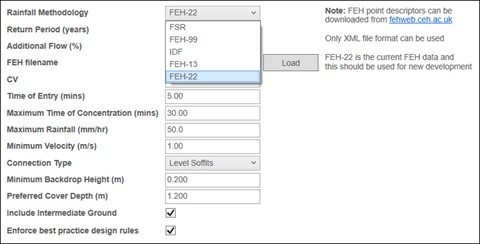*UPDATED 20 September 2024* Causeway Flow v12 is now available: The latest update supports the design of drainage networks for conveyance on steep sites by incorporating the 1-year return period using FEH13 and FEH22 rainfall data.
Causeway Flow v10.6 introduces the new and recommended FEH22 data set to stay current with the latest rainfall methodologies.
 Image caption: The latest FEH22's calibration dataset offers several improvements over FEH13, including adding substantially to the period and spatial density of calibration data.
Image caption: The latest FEH22's calibration dataset offers several improvements over FEH13, including adding substantially to the period and spatial density of calibration data.
Rainfall is an essential natural resource that sustains life on Earth. However, with increasing urbanisation and climate change, rainfall patterns have become more erratic and unpredictable. In urban areas, rainfall can cause significant damage to infrastructure, property, and the environment. Therefore, it is essential to manage rainfall effectively to prevent flooding, erosion, and water pollution. In this regard, the new synthetic Flood Estimation Handbook (FEH) 22 rainfall model and Sustainable Drainage System (SuDS) design play a critical role in managing rainfall in urban areas.
What is the FEH22 Rainfall Model?
The FEH22 rainfall depth-duration-frequency model is UK Centre for Ecology and Hydrology’s latest rainfall frequency estimation model, released in December 2022. It’s a guide for estimating flood frequency in the United Kingdom and is widely used for flood risk management and planning.
Recommended reading: FEH22, flood risk management & planning – What you need to know
Why it matters?
Rainfall estimation
It is apparent that the FEH22 rainfall model is going to be a widely used tool for rainfall estimation in the UK in the future. The model provides the latest estimates of the intensity, duration, and frequency of rainfall events at any location in the UK.
It’s based on more recent data, including new observations as well as historical rainfall data and considers factors such as rainfall intensity, duration, and frequency, as well as geographical location, terrain, and climate alterations.
It’s based on more recent data, including:
- New observations
- Historical rainfall data
- Rainfall intensity, duration & frequency
- Geographical location and terrain
- Climate alterations
Managing rainfall in urban areas
FEH22 rainfall model is likely to become essential for managing rainfall in urban areas as it provides more accurate rainfall estimates that can be used to design drainage systems and other infrastructure.
The model is expected to help engineers and planners to determine a more accurate capacity and size of drainage systems required to manage rainfall effectively. By using the model, it is possible to design drainage systems that can handle various rainfall events, including extreme events, and reduce the risk of flooding and erosion.
Schedule 3 and SuDS design
Furthermore, the government’s recent announcement that it intends to implement Schedule 3 of the Flood and Water Management Act 2010 in England as of 2024, is a game changer for SuDS design.
This will mean developers do not have an automatic right to connect drainage systems to sewers. Instead, they will need to show that SuDS are incorporated in their schemes and exhibit how the system can be maintained.
Therefore, the FEH22 rainfall model and SuDS design are going to be critical in the face of climate change and the expected comprehensive implementation of Schedule 3. Climate change is expected to increase the frequency and intensity of rainfall events, making effective management of rainfall even more critical.
By using these tools, urban areas can adapt to the changing rainfall patterns and reduce the risk of damage and disruption caused by extreme weather events.
A new way to manage rainfall and design SuDS with Flow v10.6
In anticipation of these changes, we’ve incorporated the FEH22 in the latest update of Causeway Flow to allow users to use the latest rainfall methodology to design drainage networks.
The FEH22 rainfall model and SuDS design are going to become essential tools for managing rainfall in urban areas and consultancies need to be ready. These tools allow urban areas to reduce the risk of flooding, erosion, and water pollution while enhancing biodiversity and improving air quality.
Effective management of rainfall is crucial, especially with the increasing threat of climate change. With these upcoming changes, consultancies that do drainage designs in England will need to prepare for a change in approach when integrating drainage into new developments.
Causeway Flow v10.6 is now available to users. For more information, visit causeway.com/drainage-design.
Want to get the update or having issues updating? Get in touch through the Customer Web Portal.



